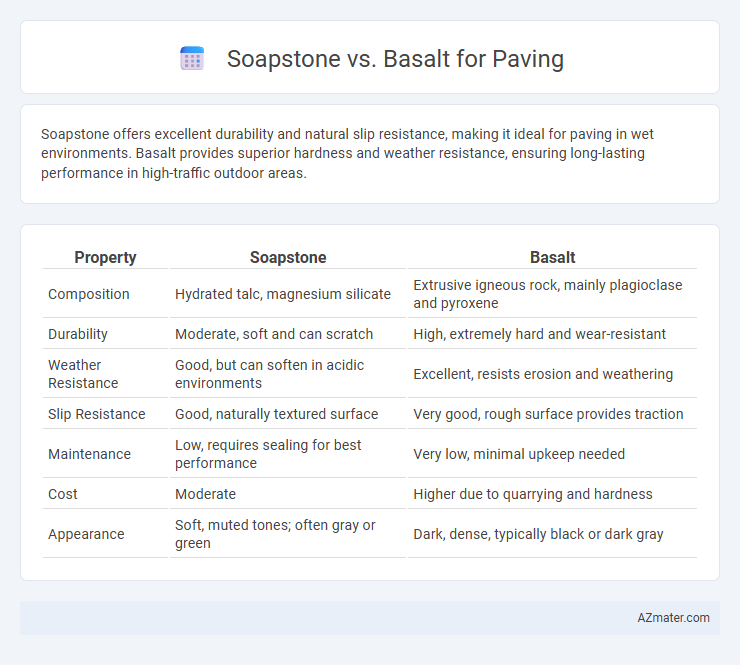Soapstone offers excellent durability and natural slip resistance, making it ideal for paving in wet environments. Basalt provides superior hardness and weather resistance, ensuring long-lasting performance in high-traffic outdoor areas.
Table of Comparison
| Property | Soapstone | Basalt |
|---|---|---|
| Composition | Hydrated talc, magnesium silicate | Extrusive igneous rock, mainly plagioclase and pyroxene |
| Durability | Moderate, soft and can scratch | High, extremely hard and wear-resistant |
| Weather Resistance | Good, but can soften in acidic environments | Excellent, resists erosion and weathering |
| Slip Resistance | Good, naturally textured surface | Very good, rough surface provides traction |
| Maintenance | Low, requires sealing for best performance | Very low, minimal upkeep needed |
| Cost | Moderate | Higher due to quarrying and hardness |
| Appearance | Soft, muted tones; often gray or green | Dark, dense, typically black or dark gray |
Introduction to Soapstone and Basalt Paving
Soapstone and basalt represent two distinct options for paving materials, each with unique geological properties and aesthetic appeal. Soapstone, a metamorphic rock rich in talc, is prized for its smooth texture and heat resistance, making it a durable choice for outdoor flooring applications. Basalt, an extrusive igneous rock formed from cooled lava, features high compressive strength and a dense, fine-grained surface that withstands heavy traffic and harsh weather conditions.
Physical Properties of Soapstone vs Basalt
Soapstone offers a softer, more workable surface with a Mohs hardness of about 1 to 2.5, making it less durable but highly resistant to heat and chemical damage. Basalt exhibits a much higher hardness, typically 6 on the Mohs scale, providing superior abrasion resistance and strength, ideal for heavy-traffic paving applications. The density of basalt, around 3.0 g/cm3, generally exceeds soapstone's 2.7 g/cm3, contributing to its increased durability and load-bearing capacity.
Durability and Longevity Comparison
Soapstone features moderate durability with natural resistance to heat and weathering, but it is softer and more prone to scratching and chipping compared to basalt. Basalt exhibits superior hardness and toughness, offering high resistance to abrasion, freeze-thaw cycles, and heavy foot traffic, making it ideal for long-lasting paving applications. The longevity of basalt paving often exceeds that of soapstone, maintaining structural integrity and appearance over decades under harsh environmental conditions.
Aesthetic Differences: Colors and Textures
Soapstone offers a soft, muted palette ranging from pale greens and greys to subtle blues, with a smooth, matte finish that enhances its natural talc-like texture. Basalt presents a darker, more uniform color spectrum, typically deep charcoal to black, featuring a fine-grained, slightly rough texture that adds ruggedness and durability to paved surfaces. These distinct aesthetic differences influence design choices, with soapstone lending a softer, organic appearance, while basalt contributes a bold, modern look to outdoor spaces.
Installation Process: Soapstone vs Basalt
Soapstone installation involves easier cutting and shaping due to its softer composition, allowing for quicker customization and fitting. Basalt requires more specialized tools and labor because of its hardness and density, leading to longer installation times. The differing hardness levels impact not only the ease of installation but also the durability and maintenance needs of the paved surface.
Maintenance Requirements for Both Stones
Soapstone requires minimal maintenance for paving, as its natural softness allows it to age gracefully while resisting staining and weathering with occasional sealing. Basalt, known for its hardness and durability, demands more frequent cleaning to prevent dirt buildup and periodic sealing to maintain its non-porous surface and prevent moss or algae growth. Both stones benefit from proper installation and routine care, but soapstone offers easier long-term upkeep in outdoor paving applications.
Weather Resistance and Outdoor Performance
Soapstone offers excellent weather resistance due to its dense, non-porous nature, making it highly durable against rain, frost, and UV exposure, ideal for paving in diverse climates. Basalt, an igneous volcanic rock, provides superior hardness and abrasion resistance, ensuring long-lasting outdoor performance and minimal wear under heavy foot traffic or harsh conditions. Both materials resist freeze-thaw cycles effectively, but basalt's natural rough texture often improves slip resistance on wet surfaces, enhancing safety in outdoor paving applications.
Cost Analysis: Soapstone vs Basalt
Soapstone paving generally incurs higher initial costs due to its rarity and extraction complexity, with prices typically ranging from $15 to $30 per square foot. Basalt offers a more cost-effective alternative, averaging between $10 and $20 per square foot, driven by its abundant availability and simpler quarrying process. Long-term maintenance costs for both materials remain low, but basalt's greater durability against weathering often results in fewer repairs and replacements over time.
Environmental Impact and Sustainability
Soapstone's extraction and processing have a lower environmental footprint due to minimal quarrying waste and reduced energy consumption compared to basalt, which requires intensive mining and higher energy for crushing and cutting. Soapstone is a highly durable natural material with excellent resistance to weathering, promoting long-term sustainability and reducing the need for frequent replacement. Basalt's higher density makes it less porous, but its extraction often disrupts ecosystems more significantly, impacting sustainability negatively in comparison to the more eco-friendly profile of soapstone.
Choosing the Right Stone: Soapstone or Basalt
Soapstone offers exceptional heat resistance and a smooth, non-porous surface ideal for areas prone to moisture, making it perfect for shaded or cooler paving environments. Basalt provides superior durability and hardness, with a dense, fine-grained texture that resists wear and weathering in high-traffic or exposed outdoor spaces. Selecting between soapstone and basalt depends on the desired balance of aesthetics, slip resistance, and long-term maintenance tailored to the specific paving location.

Infographic: Soapstone vs Basalt for Paving
 azmater.com
azmater.com